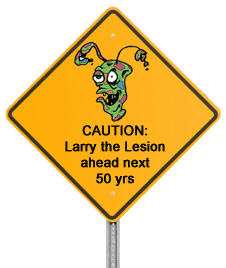2006-12-04 16:11:04
Wow. So, I'm on the super slow list for getting my MRI as it's not an urgent
request. I don't have symptoms to really warrant the MRI, only that I haven't
had one in 2 years and it's to get an updated baseline. So, I phoned the cool
people at the MRI clinic and put myself on the cancellation list. I'm on the
2 hour notice list. We'll see how long it'll take! She said I would have a better
chance if I were on the one hour list. I could only justify being on that list
if it wasen't in rush hour traffic! I'm just outside of it taking an hour to
get to UBC so fair is fair.
Osteopontin - key to identifying a relapse?
2006-12-09 21:07:13
This whole
article is worth the read. It strikes me that this article was written by
someone who really understands it too, which I find is not always the case.
Go Stanford University! Please do something with this one! "The study, to be
published in the Dec. 3 advance online edition of Nature Immunology, lays the
groundwork for a way to determine when a relapse is about to occur, and could
eventually lead to a treatment to prevent relapses. "Right now, there is no
good blood test to evaluate when a person is going to have a flare-up," said
senior author Larry Steinman, MD, professor of neurology and neurological sciences.
"If we had one, we might be able to give them prophylactic preventive medication."
The researchers also found that the relapse would occur sometimes in an area
of the brain other than the site of the original attack. For example, after
receiving the osteopontin, some animals that had previously suffered paralysis
became blind from a condition called optic neuritis. One feature of multiple
sclerosis is that the flare-ups can affect different parts of the nervous system
at different times. "When I saw that all mice with EAE relapsed and died from
the disease after about a month of osteopontin administration, I was surprised,"
said Hur, the study's first author who is now a postdoctoral scholar at Caltech.
"I got a strong belief that a high level of osteopontin in patients' blood and
tissue is a major contributor of the relapse and progression of the disease."
Through the mouse studies and molecular characterizations, Hur and Steinman
showed that osteopontin -- produced by immune cells and brain cells themselves
-- promotes the survival of the T cells that carry out the damaging attack on
myelin; by increasing the number of these T cells, osteopontin increases their
destructive potential. These results could be applicable to many other autoimmune
diseases, including rheumatoid arthritis, type-1 diabetes and lupus. Indeed,
the effect of osteopontin may severely alter the way the immune system works.
Normally, after the immune system does its job -- eradicating a microbe, for
instance -- the response is then dialed down. If this didn't happen, the immune
response would go on indefinitely. Imagine a cold or an attack of poison oak
that would last forever. One of the ways that the immune response is muffled
is that the activated T cells die in a process known as apoptosis. That is precisely
what osteopontin seems to prevent. Osteopontin lets the T cells linger in the
blood, ready to attack again. "We don't know exactly what triggers that new
attack but the cells certainly are around and ready to do it," said Steinman.
So scientists now face the challenge of figuring out how and why osteopontin
is produced. "We're back to the chicken-and-the-egg problem," said Steinman.
"We know the egg, so why did the chicken lay it? That is a trickier problem
to work out." Even without knowing the answer to that question, there is one
inviting practical use of their observations: Osteopontin could be used as a
marker of an impending relapse. What's more, if the protein could be blocked,
it might thwart the relapse from ever occurring. Steinman's lab is working to
develop antibodies to inactivate the protein's effect. "It's still a long road
between saying we want to do it and getting the antibodies, getting it approved
by the FDA and getting it tested," said Steinman, "but we are determined to
do that."
A recap
2006-12-09 21:19:29
For those that want an overview of the year of 2006 in the world of MS, here's
a little read
for ya. I've missed a couple points that I'm going to try to find some info
about. Interesting stuff. Loads of new oral meds in the queue. Here's hoping
they're ready to use by the time I need to start taking meds!
No brainer
2006-12-12 13:11:34
This article
shows that sleep disturbances contribute to fatigue in MS. Ummm... DUH! And
really, I think this pertains to everyone, MS or no MS. Tod and I are cursed
with being light sleepers and if one is tossing and turning the other kicks
in too and then both of us have a fatigue day! And last night, was one of those
nights...
12 days to go!
2006-12-12 15:56:43
Holy smokes the time is moving too fast! 12 days until Christmas and I don't
feel ready! And it's only 4 days until we get to celebrate Christmas on the
island with Tod's family so time is even shorter! I wish I had one more month
to knit. I started a little too late to get to a couple projects that I would
have liked to do for family members. And I still haven't got around to Christmas
cards or any baking! What happened!? Jeesh! The start of the work place get
togethers is this week though. So, they'll be some good food and hopefully
some time to relax some! Is everyone else done all their shopping now?
Bowmann-Birk Inhibitor Concentrate (BBIC) improved mice MS symptoms
2006-12-19 10:37:59
Wow, I'm impressed by this latest news
release on this natural soy-based substance. It's not the typical cure-all
that you see a lot in MS reasearch. This one is showing that it's reversing
symptoms to a better level in mice with EAE (the MS-like mice disease). And
it uses soy! "Animals that received BBIC were able to walk, while those that
didn't get the drug were not," study leader Dr. A.M. Rostami, professor and
chair of the department of neurology at Jefferson Medical College in Philadelphia,
said in a prepared statement. The animals that received BBIC weren't cured of
their illness and did walk with some limp or weakness. However, the results
are promising, the researchers said. They also found that the central nervous
systems of the animals that received BBIC had "significantly less inflammation
and demyelination" than animals that didn't receive BBIC. "It's the first time
that BBIC has been used in an EAE model and has shown significant disease suppression,
and we hope it can eventually be used in humans," Rostami said. BBIC inhibits
proteases, which are enzymes that play a major role in the inflammation and
demyelination associated with multiple sclerosis, in which the myelin coating
of nerve fibers become inflamed and scarred."
Vitamin D - officially connected through research to show prevention
2006-12-20 09:43:57
Yay! Good news with this research
that is now officially published about the potential impact vitamin D has on
all of us. 62% decreased risk in developing MS but interesting that this is
only for the caucasion population and does not apply to other ethnic groups.
"Maybe, according to new research that found white people with high circulating
levels of vitamin D -- a vitamin mainly produced by the body after sun exposure
-- had a lower risk of developing multiple sclerosis (MS). No such association
was found for blacks or Hispanics in this study, which is published in the Dec.
20 issue of the Journal of the American Medical Association . "The
group [of whites] with the highest vitamin D levels had a 62 percent decreased
risk compared to the group with the lowest levels," said the study's lead author,
Dr. Alberto Ascherio, an associate professor of nutrition and epidemiology at
the Harvard School of Public Health in Boston."
I'm back!
2006-12-29 09:50:36
Okay, so we had a little technical problem with my blog, but Tod fixed it and it's all back! Yay! So, Merry belated Christmas to you all! I hope you're all turkey'd up and relaxing lots before the new year begins.


